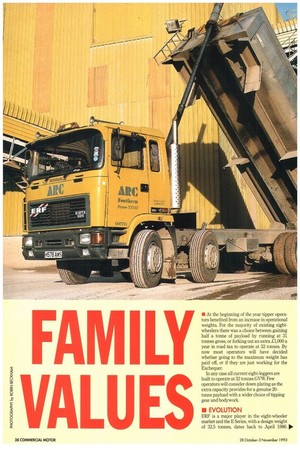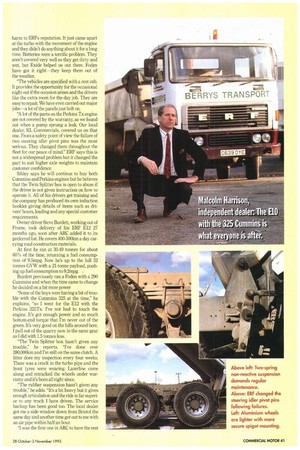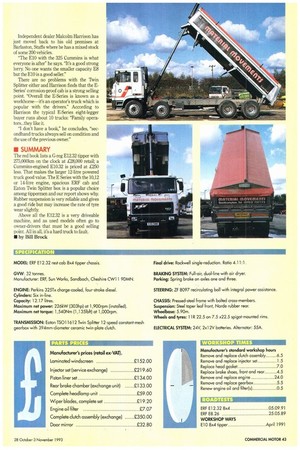• At the beginning of the year tipper operators benefited
Page 40

Page 41

Page 42

Page 43

Page 44

Page 45

If you've noticed an error in this article please click here to report it so we can fix it.
from an increase in operational weights. For the majority of existing eightwheelers there was a choice between gaining half a tonne of payload by running at 31 tonnes gross, or forking out an extra £1,000 a year in road tax to operate at 32 tonnes. By now most operators will have decided whether going to the maximum weight has paid off, or if they are just working for the Exchequer.
In any case all current eightleggers are built to operate at 32 tonnes GVW. Few operators will consider dow-n plating as the extra capacity provides for a genuine 20tonne payload with a wider choice of tipping gear and bodywork
• EVOLUTION
ERF is a major player in the eight-wheeler market and the E Series, with a design weight of 32.5 tonnes, dates back to April 1986.
ERN E-Series eight-leggers offer the kind of rugged dependability that tippermen appreciate more than most. The operators and dealers we spoke to found little to complain of...
ERF's hadging policy is a bit misleading because installed output figures are substantially reduced. So the 8x4 E12.320 tested by Commercial Motor in September 1991 with the more powerful of the two Perkins Tx Eagle options was rated at just 226kW (303hp) hut still remained about 20% above the industry average at that time. Its high torque output and low engine speed lends itself to good acceleration, fast hill climbing and commendable flexibility Compared with other current eight -leggers it returned the best A-road fuel consumption at 31.1 lit/100km (9.08mpg). It also bears comparison with the best over the motorway section, returning 31.6 lit/100km (8.94mpg). Innovations included a centrifugal oil filter which allows longer oil change intervals and an effective sliding-gate exhaust brake. An all-speed mechanical governor ensures a smooth PT-0 drive and the helical gears used to drive the fuel pump and compressor contribute to the overall noise reduction. Despite the lack of roll bars the Norde rubber suspension is stiff enough to resist chassis roll, irrespective of speed or load On site without a load it is certainly possible to lift the occasional wheel but inter-axle and cross-axle differential locks help maintain traction. When unladen rubber suspension can
be bouncy but with a full load the ride, helped by an air-suspension seat, was very good Under max imum braking effort the E12 remained stable and produced shorterthan-average stopping distance&
Three steps give easy access to the cab. Inside, the dog-leg fascia houses neat halfmoon instruments but the tacho looks like an afterthought. Rubber mats suit the working environment but headlights can easily be misaligned if the composite bumper should get a slight knock. Payload is the main drawback—it was 680kg down on the Leyland Daf Constructor we tested in 1988. Until it was replaced by the EC Series this year it offered a choice of 8.0, 10.0, 12.0 and 14.0 litres with no less than seven engine options. Each model adopts the engine capacity and nominal power rating in its badge designation. As standard the E Series comes with the 12speed Eaton Twin Splitter gearbox and Norde rubber suspension.
It was introduced with the Cummins L10 250 engine rated at 243hp on two wheelbases at 5.89 and 6.47m. In May 1986 the 290 charge-cooled version of the 10-litre unit boosted the power to 275hp. This was offered alongside the 253hri 12.68-litre Gardner 6LXDT which remained available until the latter part of 1990.
In the spring of 1988 wheelbases were extended to 5.90, 6.50 and 6.80m and the smaller Cummins 8.27-litre C-Series engine was added to the list, rated at 245hp for the lightweight E8. It was soon followed by a charge-cooled LTAA 10.325 which was rated at 305hp.
A lower power option of the charge-cooled L10 arrived in January 1989 and the C-Series was boosted slightly that September.
Perkins took over the E12 slot with the Tx 300 and Tx325 in September 1989 with installed ratings of 287 and 302hp; Cummins' 14-litre NTE320 was introduced at the same time.
• OPERATORS
The Sibleys have been in business in the Southampton area for 97 years. Today Ron Sibley and his son John run the business, Material Movements, with 40 vehicles including 30 eight-wheel tippers. They work in the south of England from the Mendips to Kent, mainly hauling aggregates and tarmacadam The fleet is split about 50/50 between Leyland Dafs and ERFs powered by a mixture of Cummins and Perkins power units.
They took delivery of their first E12.32 after ERF exhibited it at the RHAs 1990 TipCon Show and it covers an average of 80,000km a year.
"We've got the Rolls Eagle in the Leyland 330s and we like it because it doesn't drink oil," says Sibley. "All of our drivers carry a topup can and five litres lasts for months." To substantiate this he pulled out some computer records for the past quarter which showed an average use of two litres against 14 litres for the Cummins-engined vehicles.
"Fuel consumption is also very important to us," he adds. "Across the fleet it varies from 7.5 to 8.2mpg—the E12's returning about 8mpg . We try to work them over a triangle so they run about 70% fully laden. With the Perkins engine the ERF is down on payload Most of our customers are geared to receiving 20-tonne loads and now we have uprated them to 31 tonnes we can meet that comfortably. I object to paying the extra £1,000 to run at 32 tonnes but our second 32-tonner is coming shortly. Rubber suspension is reliable but it's very stiff laterally and causes the tyres to wear faster.But the drivers like the smooth ride and they have also commented on the fact that the Perkins Tx is a lot quieter than the Cummins engine. There is a premium to pay for the non-reactive spring bogie but it gives better articulation for site work.
"We only fit new tyres. Tarmac is a perishable load and we can't afford to have blowouts. If the load is late then the haulier pays. It used to be our aim to replace after five years but we have extended that to eight. The specification has improved and everything lasts a lot longer today so age is no longer the same deterrent to running them. But we have continued to buy new vehicles through the recession; they are mostly part exchanged. Both the Leylands and the ERFs are always in demand The drivers prefer the ERF— they consider it is a better vehicle. We always come out on top of the amount it been written down, "We use alloy wheels and torque them up. We had a wheel-loss problem when we fitted steel rims: the spigot mounting is more secure and they are a bit lighter. We have just taken on the Edbro agency for the area so it's natural that we use their tipping gear now. All the trucks are sheeted and new ones will be fitted with the Roll Top. It only takes three minutes to cover the load and it can be done from the ground.
'We spend an awful lot of money on maintenance but it pays off in reliability. There have been some problems; the cross bracing on some of the early radiators cracked. ERF put it right and I can't remember the last one we replaced. The vertical exhaust did more harm to ERFs reputation. It just came apart at the turbo with the movement of the engine and they didn't do anything about it for a long time. Batteries were a terrific problem. They aren't covered very well so they get dirty and wet, but Exide helped us out there. Foden have got it right—they keep them out of the weather.
"The vehicles are specified with a rest cab. It provides the opportunity for the occasional night out if the occasion arises and the drivers like the extra room for the day job. They are easy to repair. We have even carried out major jobs—a lot of the panels just bolt on.
"A lot of the parts on the Perkins Tx engine are not covered by the warranty, as we found out when a pump sprung a leak. Our local dealer, KL Commercials, covered us on that one. From a safety point of view the failure of two steering idler pivot pins was the most serious. They changed them throughout the fleet for our peace of mind." ERF says this is not a widespread problem but it changed the part to suit higher axle weights to maintain customer confidence.
Sibley says he will continue to buy both Cummins and Perkins engines but he believes that the Twin Splitter box is open to abuse if the driver is not given instruction on how to operate it. All of his drivers get training and the company has produced its own induction booklet giving details of items such as drivers' hours, loading and any special customer requirements.
Owner-driver Steve Burdett, working out of Frome, took delivery of his ERF E12 27 months ago, soon after ARC added it to its preferred list. He covers 400-500km a day carrying road construction materials.
At first he ran at 30.49 tonnes for about 60% of the time, returning a fuel consumption of 9.5mpg. Now he's up to the full 32 tonnes GVW with a 21.tonne payload, pushing up fuel consumption to 9.2mpg.
Burdett previously ran a Foden with a 290 Cummins and when the time came to change he decided on a bit more power "Some of the boys were having a bit of trouble with the Cummins 325 at the time," he explains, "so I went for the E12 with the Perkins 325Tx. I've not had to touch the engine. It's got enough power and so much bottom-end torque that I'm never out of the green. It's very good on the hills around here. I pull out of the quarry now in the same gear as did with 1.5 tonnes less.
"The Twin Splitter box hasn't given any trouble," he reports. "I've done over 280,000km and I'm still on the same clutch. A fitter does my inspection every four weeks. There was a crack in the turbo pipe and the front tyres were wearing. Lazerline came along and retracked the wheels under warranty and it's been all right since.
"The rubber suspension hasn't given any trouble," he adds. "it's a bit heavy but it gives enough articulation and the ride is far superior to any truck I have driven. The service backup has been good too. The local dealer got me a side window down from Bristol the same day and another time got out to me with an air pipe within half an hour.
"I was the first one in ARC to have the rest cab," he adds. "All the boys are looking for it now. It's got a blind spot on the near side at the
r bottom of the screen
but I can see the bumper using the idiot mirror above the door. It's a good size, the bunk folds up, there's box on top of the engine for your junk and the heater is fantastic. 1 would have liked an adjustable steering column but that came along just after I got this one. Even with a front-end ram there is room behind for a 22ft 6in body.
"The truck was specified with an insulated body from Neville Charrold. It's tried and tested and the best. I'm fed up with the mess the Hi-Tech ram's wet seals make, I'll make sure I've got dry seals next time and may change to Edbro or Harsh.
I'll probably sell it privately sometime next year. It's holding it price quite well: its dropped about £13,000 in two years. I'll replace it with the EC 335 or maybe with the Cummins 350 Celect."
Martin Cawley of Cawley Brothers, based at Llandrwst, north Wales, has a mixed fleet of 25 vehicles which is dominated by ERFs. He bought his first 8x4 E12 on a G-plate and has since added five more.They operate nationwide, covering 2,500-3,000km a week transporting mainly stone, coal and salt. "The payload of 21 tonnes is not as much as some get," says Cawley, "but they are equipped with specially durable insulated bodies built for us by Stag Bodies of Stoke. We get about 7.5 to 8,0mpg depending on the work and we try to run full all the time. The torque is particularly good for operation in hilly areas like north Wales.
"We do all our own servicing and that includes extended oil changes which is every 40,000km for the E12. Backup has been fine as we have developed good contacts with the local dealer, ERF and Perkins. There have been no major problems with the vehicles but the two-spring non-reactive suspension needs
a lot of maintenance so we have gone back to the Norde. The bolsters have to be changed eventually but they are proving very reliable. We normally replace them after seven years and the cabs look as good as they can for their age. There is no rust."
• DEALERS
According to a local operator, "Its all happening down in the west country with eightwheelers." We asked Mike Jakeways of ERF Bristol for his secret: "Its just that I'm in the middle of a very strong tipping area," he says,"but you won't find many secondhand E12,32s around here, they haven't been around long enough yet. Any that do come onto the market are snapped up very quickly. Under normal circumstances I wouldn't expect them to change hands until they' are four or five years old. People in the South-West look for higher powered vehicles to work long distances as well in the local hilly areas. The 320 14-litre Cummins is also a popular choice of engine. Anyone buying now must also consider the implications of the lower speed limits.
"About 98% of operators take the Twin Splitter with only the occasional 13-speed Fuller," he reports. "The E12 is good value for money but how good depends on who had the last price increase. Secondhand the E12 is going well above book, that's if you can find one. Independent dealer Malcolm Harrison has just moved back to his old premises at Barlaston, Staffs where he has a mixed stock of some 200 vehicles.
"The El0 with the 325 Cummins is what everyone is after" he says. "It's a good strong lorry. No one wants the smaller capacity ES but the El0 is a good seller."
There are no problems with the Twin Splitter either and Harrison finds that the ESeries' corrosion-proof cab is a strong selling point. "Overall the E-Series is known as a workhorse—it's an operator's truck which is popular with the drivers." According to Harrison the typical E-Series eight-legger buyer runs about 10 trucks: "Family operators...they like it.
"I don't have a book," he concludes, "secondhand trucks always sell on condition and the use of the previous owner."
• SUMMARY
The red book lists a G-reg E12.32 tipper with 275,000km on the clock at £28,000 retail; a Cummins-engined E10.32 is priced at £250 less. That makes the larger 12-litre powered truck good value. The E Series with the 10,12 or 14-litre engine, spacious ERF cab and Eaton Twin Splitter box is a popular choice among tippermen and our report shows why. Rubber suspension is very reliable and gives a good ride but may increase the rate of tyre wear slightly
Above all the E12.32 is a very driveable machine, and as used models often go to owner-drivers that must be a good selling point. All in all, it's a hard truck to fault.
• by Bill Brock
































































































